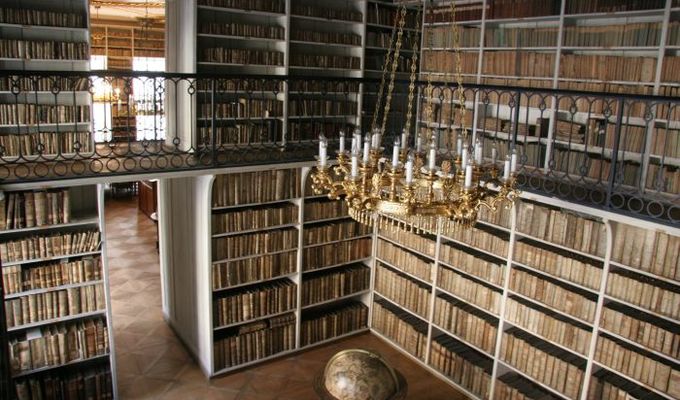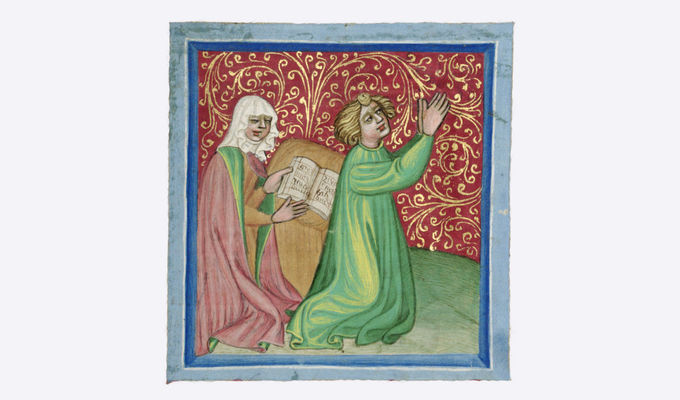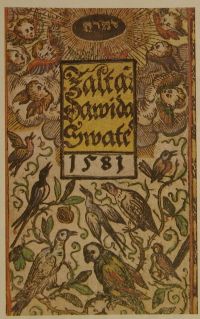The Department of Manuscripts and Early Printed Books administers the most valuable collections of the National Museum Library (NML):
- the collection of manuscripts, comprising more than 6,000 volumes
- the collection of incunabula
- a selected collection of mostly early printed Bohemica
- two palace libraries: the Nostitz Fideicommissum Library and the Palace Library of the Counts Kinsky.
A part of this department is a conservation laboratory.
The foundations of the manuscript collection were laid by generous gifts from museum supporters already in the 19th century. These included the collection from the library at Castle Březnice, containing a large part of the rarest manuscripts, e.g. Mater verborum, a dictionary from the 13th century and the Jaroměř Bible, a remarkable example of the French illumination art of the second half of the 13th century. The archbishop Václav Leopold Chlumčanský gave the NML Liber viaticus and Orationale Arnesti, two manuscripts from around the middle of the 14th century, whose depictions can be found in all major works on Bohemian illuminated manuscripts. Nevertheless, the thematic composition of the collection is much broader, including works on both social and natural sciences. Like in the case of the manuscript collection, the largest part of also the collection of early printed books (25,000 volumes) consists of gifts. Besides the above-mentioned museum supporters and founders, it comprises the libraries of Franz Anton von Kolowrat-Liebsteinsky and Franz Josef von Klebelsberg.
From the beginning, the collection of early printed books focused on Bohemica, i.e. it was to contain mainly works written in Czech or otherwise related to the Czech lands. The Nostitz Fideicommissum Library, built from the 17th century, came after the confiscation in 1945 under the administration of the National Museum. It comprises approximately 14,000 volumes and continues to be deposited in the original Baroque interiors of the Nostitz Palace in the Lesser Town of Prague.
The Kinsky Library was founded through the one-time purchase of 18,000 volumes at the beginning of the 19th century. By 1945, when it was confiscated from the original owners, this number had increased to more than 33,000 volumes. Significant parts of this library include a collection of book graphic designs and literature from the French Revolution.
The main tasks of the Department of Manuscripts and Early Printed Books include the provision of access to its collections for researchers, the cataloguing and description of individual collections. Manuscripts and early printed books are accessible for research online mainly through the Manuscriptorium and Portaro digital libraries. The catalogue of Czech-language early printed books is accessible online within the electronic retrospective bibliography Knihopis. Foreign-language printed Bohemica from 1501–1800 are recorded in the catalogue Bibliography of Foreign-Language Printed Bohemica.
The Department of Manuscripts and Early Printed Books provides access to its printed collections through the online catalogue Portaro and in the form of the scanned card catalogue in the RetrIS system.
The conservation laboratory is part of the Department of Manuscripts and Early Printed Books, but it also provides its services to other departments of the National Museum Library. The conservators ensure comprehensive protection of the physical condition of the historical book collections ranging from preventive care (the control and maintenance of stable climatic conditions, inspections of the condition of the collections, precautions for handling rare books, the production of specific protective packaging, the supervision of the transport and installation of exhibits at exhibitions and during digitisation, on-site conservation and restoration interventions) to complex restoration interventions using chemical-technological analyses and instrumentation. All interventions are recorded and documented in detail.



